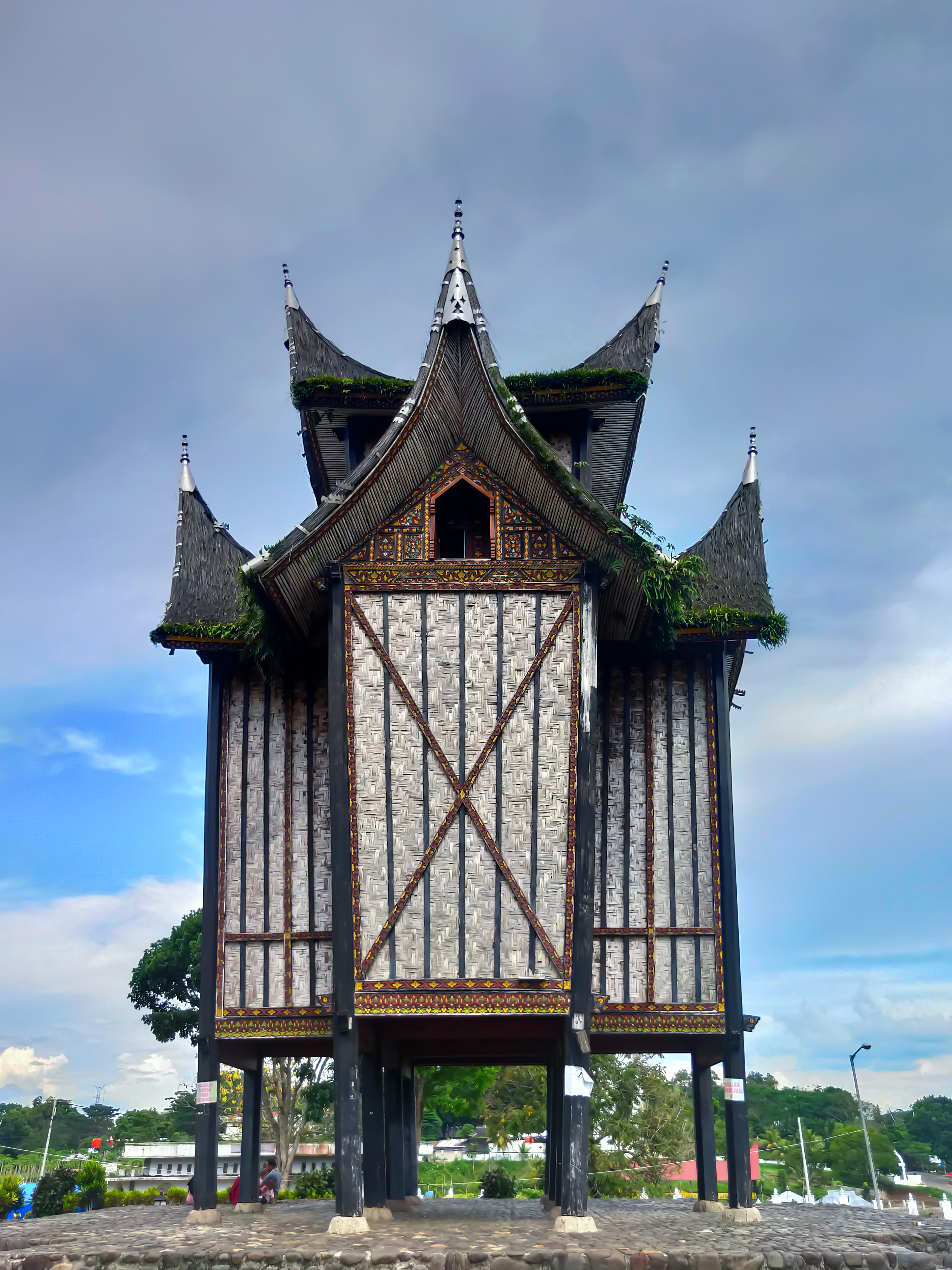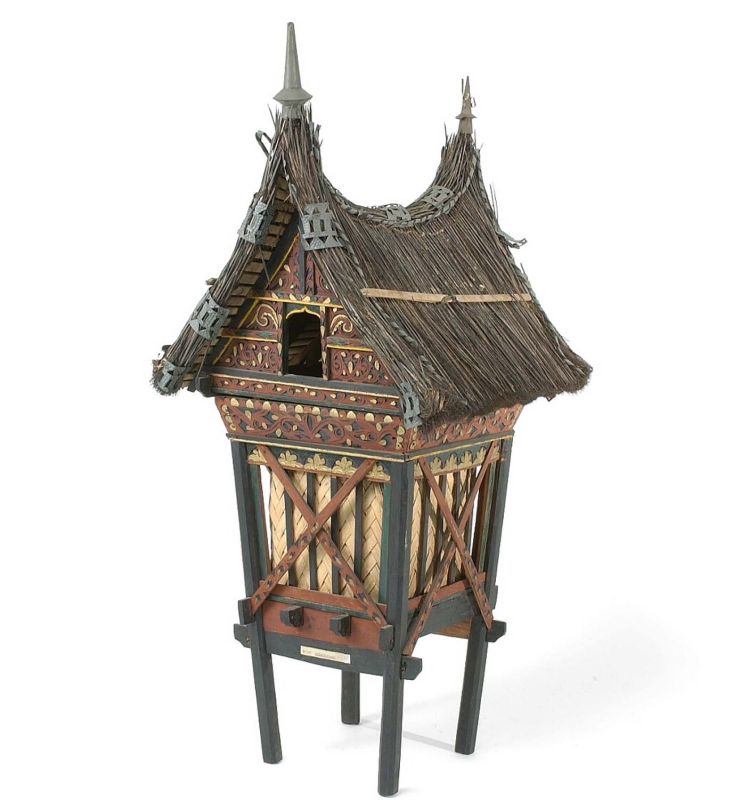Rangkiang on:
[Wikipedia]
[Google]
[Amazon]
 Rangkiang (also lumbuang) is a
Rangkiang (also lumbuang) is a
 A ''rangkiang'' is a structure built over a raised pile foundation, an Austronesian legacy that can be found anywhere else in Indonesia. It has a distinguished roof shape known as ''gonjong'' ("spired") roofs, similar to a Minangkabau traditional house, the rumah gadang. The ''gonjong'' roof symbolically identifies it with buffalo horns. Similar to the rumah gadang, the roof of a rangkiang is traditionally a thatched roof made of palm fibre (''ijuk''), and it is also similarly decorated. The only opening to a rangkiang is a small rectangular hatch high up in the gable end, into which the harvested rice is placed. A ladder is required to reach this hatch.
A rangkiang is traditionally built on the courtyard of a rumah gadang. There are three types of rangkiangs according to its function. A rangkiang which is used to store rice that is to be consumed by the inhabitants of the house is known as ''si bayau-bayau''. This rangkiang, the largest of all rangkiang, is traditionally supported by a minimum of six poles; in the case of a royal palace —such as the rangkiang of the
A ''rangkiang'' is a structure built over a raised pile foundation, an Austronesian legacy that can be found anywhere else in Indonesia. It has a distinguished roof shape known as ''gonjong'' ("spired") roofs, similar to a Minangkabau traditional house, the rumah gadang. The ''gonjong'' roof symbolically identifies it with buffalo horns. Similar to the rumah gadang, the roof of a rangkiang is traditionally a thatched roof made of palm fibre (''ijuk''), and it is also similarly decorated. The only opening to a rangkiang is a small rectangular hatch high up in the gable end, into which the harvested rice is placed. A ladder is required to reach this hatch.
A rangkiang is traditionally built on the courtyard of a rumah gadang. There are three types of rangkiangs according to its function. A rangkiang which is used to store rice that is to be consumed by the inhabitants of the house is known as ''si bayau-bayau''. This rangkiang, the largest of all rangkiang, is traditionally supported by a minimum of six poles; in the case of a royal palace —such as the rangkiang of the  Other rangkiang, known as ''rangkiang kaciak'' ("little granary"), is used to keep rice seedlings (''padi abuan'') for agricultural purpose. This rangkiang used a simple gable roof instead of the elaborate Minangkabau roof form, thus it looks the simplest of all rangkiang.
The number of rangkiang, as well as the degree of ornaments that decorates the rumah gadang, shows the wealth of the owner. The more rangkiang possessed by a family, the more prestigious the owner is.
Other rangkiang, known as ''rangkiang kaciak'' ("little granary"), is used to keep rice seedlings (''padi abuan'') for agricultural purpose. This rangkiang used a simple gable roof instead of the elaborate Minangkabau roof form, thus it looks the simplest of all rangkiang.
The number of rangkiang, as well as the degree of ornaments that decorates the rumah gadang, shows the wealth of the owner. The more rangkiang possessed by a family, the more prestigious the owner is.
 Rangkiang (also lumbuang) is a
Rangkiang (also lumbuang) is a granary
A granary is a storehouse or room in a barn for threshed grain or animal feed. Ancient or primitive granaries are most often made of pottery. Granaries are often built above the ground to keep the stored food away from mice and other animals ...
or rice barn of the Minangkabau people used to keep rice. The rangkiang is a distinctive feature of Minangkabau architecture. The structure is traditionally found in the courtyard of a '' rumah gadang'', the traditional house of Minangkabau people.
Etymology
The word ''rangkiang'' is a shortened version from theMinangkabau Minangkabau may refer to:
* Minangkabau culture, culture of the Minangkabau people
* Minangkabau Culture Documentation and Information Center
* Minangkabau Express, an airport rail link service serving Minangkabau International Airport (''see belo ...
word ''"ruang hyang (Dewi Sri)"'' ("room of goddess (Dewi Sri
Dewi Sri or Shridevi ( Javanese: ꦢꦺꦮꦶꦱꦿꦶ, Balinese: ᬤᬾᬯᬶᬲ᭄ᬭᬶ, Dewi Sri)( Sundanese: ᮑᮄ ᮕᮧᮠᮎᮤ ᮞᮀᮠᮡᮀ ᮃᮞᮢᮤ, Nyai Pohaci Sanghyang Asri) is the Javanese, Sundanese, and Balinese Hindu ...
)"), the goddess of rice.
Architecture
 A ''rangkiang'' is a structure built over a raised pile foundation, an Austronesian legacy that can be found anywhere else in Indonesia. It has a distinguished roof shape known as ''gonjong'' ("spired") roofs, similar to a Minangkabau traditional house, the rumah gadang. The ''gonjong'' roof symbolically identifies it with buffalo horns. Similar to the rumah gadang, the roof of a rangkiang is traditionally a thatched roof made of palm fibre (''ijuk''), and it is also similarly decorated. The only opening to a rangkiang is a small rectangular hatch high up in the gable end, into which the harvested rice is placed. A ladder is required to reach this hatch.
A rangkiang is traditionally built on the courtyard of a rumah gadang. There are three types of rangkiangs according to its function. A rangkiang which is used to store rice that is to be consumed by the inhabitants of the house is known as ''si bayau-bayau''. This rangkiang, the largest of all rangkiang, is traditionally supported by a minimum of six poles; in the case of a royal palace —such as the rangkiang of the
A ''rangkiang'' is a structure built over a raised pile foundation, an Austronesian legacy that can be found anywhere else in Indonesia. It has a distinguished roof shape known as ''gonjong'' ("spired") roofs, similar to a Minangkabau traditional house, the rumah gadang. The ''gonjong'' roof symbolically identifies it with buffalo horns. Similar to the rumah gadang, the roof of a rangkiang is traditionally a thatched roof made of palm fibre (''ijuk''), and it is also similarly decorated. The only opening to a rangkiang is a small rectangular hatch high up in the gable end, into which the harvested rice is placed. A ladder is required to reach this hatch.
A rangkiang is traditionally built on the courtyard of a rumah gadang. There are three types of rangkiangs according to its function. A rangkiang which is used to store rice that is to be consumed by the inhabitants of the house is known as ''si bayau-bayau''. This rangkiang, the largest of all rangkiang, is traditionally supported by a minimum of six poles; in the case of a royal palace —such as the rangkiang of the Pagaruyung Palace
Pagaruyung Palace ( min, Istano Basa Pagaruyuang) is the ''istana'' (royal palace) of the former Pagaruyung Kingdom, located in Tanjung Emas subdistrict near Batusangkar town, Tanah Datar Regency, West Sumatra, Indonesia. It was built in the trad ...
— it can be supported by as many as twelve poles. This rangkiang is traditionally located to the right end of a rumah gadang's courtyard.
Another type of rangkiang is ''si tinjau lauik'' ("the one that explores the sea") used to keep rice that is to be sold. The resulting money is used to buy things that the family cannot produce themselves. This rangkiang is traditionally located in the middle of a rumah gadang's courtyard. It is supported by four poles.
Another type of rangkiang is the ''si tanggung lapar'' or ''si tangguang lapa'' or ''si tangka lapa'' ("the one the supports hunger"), which is used to store surplus rice for use in times of scarcity. This type of rangkiang is traditionally positioned to the left end of a rumah gadang courtyard. It is basically identical with the ''si tinjau laut'', being supported by four poles.
 Other rangkiang, known as ''rangkiang kaciak'' ("little granary"), is used to keep rice seedlings (''padi abuan'') for agricultural purpose. This rangkiang used a simple gable roof instead of the elaborate Minangkabau roof form, thus it looks the simplest of all rangkiang.
The number of rangkiang, as well as the degree of ornaments that decorates the rumah gadang, shows the wealth of the owner. The more rangkiang possessed by a family, the more prestigious the owner is.
Other rangkiang, known as ''rangkiang kaciak'' ("little granary"), is used to keep rice seedlings (''padi abuan'') for agricultural purpose. This rangkiang used a simple gable roof instead of the elaborate Minangkabau roof form, thus it looks the simplest of all rangkiang.
The number of rangkiang, as well as the degree of ornaments that decorates the rumah gadang, shows the wealth of the owner. The more rangkiang possessed by a family, the more prestigious the owner is.
Modern use
A facade of a Minangkabau restaurant is sometimes decorated with a single ''gonjong'' roof which represents the roof of a rangkiang as a symbol of rice and food provision for people.See also
* Rice barn *Leuit
Leuit is a type of vernacular rice barn found in the Sundanese architecture of Western Java, Indonesia. It used to store rice after harvest for future and daily use. A leuit is an essential part of Sundanese agricultural tradition, especiall ...
* Rumah gadang
References
Works cited
* * * * *External links
* {{Indonesian architecture Rumah adat Granaries Minangkabau Architecture in Indonesia